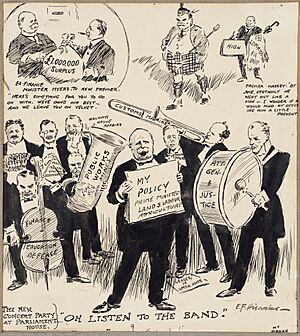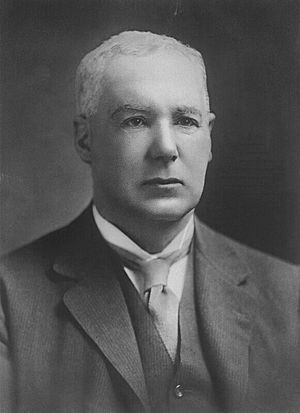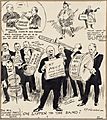Reform Government of New Zealand facts for kids
The Reform Government of New Zealand was the group of people who ran New Zealand from 1912 to 1928. It was led by the Reform Party, which was a conservative political party.
This government is often remembered for its strong stance against trade unions during big worker strikes. These included the Waihi miners' strike in 1912 and a large dockworkers' strike in 1913. The Reform Government also led New Zealand during World War I. During the war, they even teamed up with the Liberal Party to form a temporary coalition government.
Contents
Important Things the Government Did
Helping Workers and Businesses
- The government took the side of employers during the 1912 Waihi miners' strike and the 1913 waterfront workers' strike. During the 1913 strike, ordinary people who signed up to help keep order were called 'special constables' or 'Massey's Cossacks'.
- The Board of Trade Act (1919) gave the government power to control industries. This was done to help the country's economy.
Changes to Government Jobs
- The Public Service Act (1912) changed how people got jobs in the government. Before, jobs might be given based on who you knew (political favouritism). This new law put a commissioner in charge. This made sure jobs were given based on skills and fairness.
Social Support and Welfare
- A program was started in 1913 to help young people on probation.
- In 1912, pensions (regular payments) for widows were expanded. This meant wives of patients in mental hospitals could also receive them.
- From 1914, families could pay less income tax if they had dependent children.
- The Miners Phthisis Act (1915) gave pensions to miners. These were for those who became completely sick from a lung disease called pneumoconiosis.
- Pensions were also introduced for miners' widows in 1915.
- The War Pensions Act of 1915 started pensions for war widows. From 1916, these were paid without checking how much money the person had.
- The Housing Act (1919) allowed local councils to borrow government money. This money was used to build homes for workers.
- The system for war pensions was made bigger in 1919.
- In 1919, women were allowed to become Members of Parliament.
- Pensions for blind people were started in 1924.
- In 1926, family allowances were introduced. These were payments for families, starting from their second child.
- A law in 1922 put farm products more under the control of special boards.
- Special courts for children, called Children's Courts, were set up in 1925.
- Borstal institutions, which are special places for young offenders, were created in 1924.
- The Child Welfare Act 1925 made it compulsory to check on the living conditions of all children born outside of marriage.
Education Improvements
- The Education Act (1914) made it mandatory for public high schools to accept students for free.
- The age when children could leave school was raised to 14 in 1914.
Foreign Relations and Military
- The government brought New Zealand into World War I alongside Britain and the Allies. You can learn more at Military history of New Zealand in World War I.
- In 1916, they introduced conscription. This meant that men aged 17 to 60 had to register and could be forced to join the military. This followed the National Registration Act of 1915.
How the Government Started
For a long time in New Zealand, governments were not made up of political parties. Instead, they were loose groups of individuals who changed often. But in the 1880s and 1890s, the first real political party, the Liberals, was formed. They became the Liberal government in 1890 and stayed in power for over 20 years. This was because they had popular policies, strong leaders, and a good party structure.
The groups against the Liberals were not well organized at first. William Massey became the Leader of the Opposition in 1903. By 1909, these opposition groups had come together to form a new party called the Reform Party, led by Massey.
In the 1911 election, the Reform Party won more seats than the Liberal Party. However, some independent Members of Parliament (MPs) held the balance of power and supported the Liberals. But over the next few months, enough independent MPs switched their support. This caused the Liberal government to lose a confidence vote, which meant they no longer had enough support to govern. Because of this, the Reform Party came to power in July 1912.
The 1914 Election and Wartime Team-Up
After the 1914 election, the Reform Party only had 40 out of 80 seats in Parliament. This meant they didn't have a clear majority. At this time, only one independent MP was left, and two small workers' parties were in Parliament. None of these were likely to join with the right-wing Reform Party.
However, World War I had started earlier that year. This created a strong need for national unity. So, the Reform Party formed an unexpected team-up with the Liberal Party, the very party they had been created to defeat! Massey remained Prime Minister, and Liberal leader Joseph Ward became an unofficial co-leader.
The small workers' parties, United Labour and Social Democrats, were against the war, especially conscription (forcing people to join the military). In 1916, they combined to form the New Zealand Labour Party. This new party became the official opposition. Some Labour MPs were even jailed for speaking out against conscription or for refusing to join the military.
The 1919 Election
The wartime team-up became harder to manage, partly because Massey and Ward didn't get along well. After the war ended in November 1918, the team-up broke apart. The two parties then ran against each other in the next election. The Reform Party won six more seats, finally getting a clear majority in Parliament.
The 1922 Election
Economic problems made the government less popular. After the 1922 election, the Reform Party only had 37 seats. This was four seats short of a majority. Massey had to put together a new group with Reform MPs, independent MPs, and two Liberal MPs. The Labour Party was gaining a lot of support, which made Massey worried that they would soon become more powerful than the Liberals.
The 1925 Election
Labour continued to grow in popularity. In the 1925 election, they won more seats than the Liberals. The two parties were competing for many of the same voters. This actually helped the Reform Party. Even though Reform gained 18 more seats, their share of the total votes only went up by a small amount. This suggests they benefited from votes being split between the Labour and Liberal parties in many areas.
The 1928 Election
After doing very poorly in the 1925 election, the Liberal Party changed its name to the United Party. They managed to regain some of their popularity. In the 1928 election, both Reform and United won 27 seats. The Labour Party held the balance of power with 19 seats. Since Labour was a long-time opponent of Reform, they supported the United Party. This allowed the United Party to take power, ending the Reform Government.
Prime Ministers of the Reform Government
The Reform Government was led by William Massey from July 10, 1912, until he passed away on May 10, 1925.
After Massey, Francis Bell briefly became Prime Minister from May 14 to May 30, 1925. He had been acting Prime Minister before, but he decided not to take the job permanently.
Then, Gordon Coates was appointed Prime Minister on May 30, 1925. He held the position until December 10, 1928, when his party lost the 1928 general election.
Images for kids









